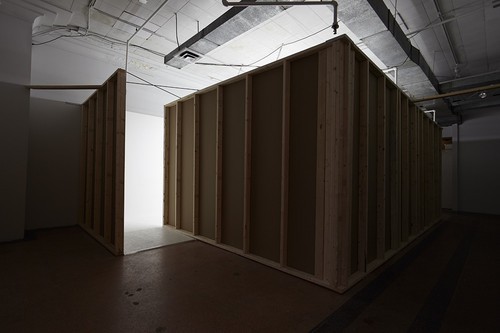The proposal of a BDSM themed group exhibition sounds gimmicky off the bat, like something that might exist as a for-profit museum venture in a Euro tourism zone, but the local buzz that preceded the group show xXx at Current Space Gallery this November indicated more serious expectations. Obviously, the conversations regarding sex practices that rely on a certain level of theatre have a lot of ground to cover when the issues at hand cover power relationships, consensual violence, trust agreements, and so on. These topics resonate with the deeper frequencies in any social sphere since a binary between an inside, theatrical world and an outside, encompassing world relies on the general vibrations that are felt in whichever is deemed to be “real,” be that inside or outside.

James Bouché, Colin Schappi, and Laura Judkis certainly express this complexity in the space. There is nothing in the show that would primarily lend itself to the realm of the sexual (whatever that may be), but this proves to be no barrier for each object’s recontextualization. The fluorescent glow and a strictly black/white/chrome monochrome palette shared between the artists’ works reflects a gesture towards the surgically sterile. Schappi focuses on surface in a way that attempts to remove his hand from the equation: two of his pieces focus on metal links, one a perfectly chrome plated four ring chain-link (made of cock rings), the other a single bike lock fastened to and balanced on a simply designed bike port. His third piece uses the gallery wall to emboss an old, esoteric symbol (a triquetra) on the dry wall plaster. Bouché uses glass planes, stainless steel, and black straps to work in a related language, while Judkis balances the feel of the space with her black, tar-beaten forms that stand in contrast to the cleanliness of Schappi and Bouché.
The all-business, no frills statement included by the artists focuses on an ambiguity in potential between objects, pointing to an ability for repossessing tools in both directions, the “dark potential” in the everyday as well as the controllable in the violent. Between the artists, Bouché’s pieces are the most attention grabbing. On one wall, uniform black ratchet straps alternatingly attached to floor and ceiling (each with industrial strength tension) support a large plane of glass by matching downward with upward pull. The delicate, wavering stasis and minimal form hypnotizes while, in a corner across the room, another piece by Bouché uses hundreds (or thereabouts) of basic, chrome wall hooks to form a column replicating some gesture of an iron maiden, a sadistic cradle of sorts. Unlike the rest of the works in xXx, this piece relies on a gestalt relationship more frequently seen in painting, seen here with a sort of flickering between the recognized consumer object and the unfamiliar threatening object.

Surprisingly, the most dramatic move in the show is the space itself. I’m not familiar with any instance of erecting a gallery within a gallery, but it was done here with an incredible attention to detail. (Maybe the more surprising bit is that such an ambitious undertaking was made viewable for only two weeks.) The gesture on one hand is domineering, showing the artists could imagine a space better for their work than what Current could offer, but I’m maybe more interested in the way I’m forced to read the gallery walls as theatre veneers marking inside from outside. Walking past exposed lumber and drywall work makes the space have a definite stage left, stage right, entrance and exit. In the conversation about the latent darkness in the everyday, this move has more impact on that discussion and my own meditations on whether the theatrical inside or the encompassing outside has more weight as “truth” than the individual pieces of the show. In the back and forth between the everyday and the violent, what makes one more real from the other?
In a space made as sterile as this one, Schappi’s metal link pieces leave me a little cold with their industrial design references. I’m more attracted to his drywall embossment with its softness and subtleties of craft. In Judkis’ work, the relationship between wood, fibers, and heavy, sticky, blackness is deeply satisfying, but I wonder if that feeling would remain if these pieces weren’t working to balance out the stuffy cleanliness found in every other aspect of the show. That being said, I enjoy each artist’s success in cultivating a heightened awareness for the sensual in the industrial.

I spent some time enjoying what the cartoon opposite of this show might look like–low lit, red satin, deeply warm tones all around, that’s what sexuality and romance is, right? Susan Sontag comes to mind here, “There hardly seems to be anything that’s purely sexual: it’s overloaded with other forms of affirmation and destruction that you are declaring when you engage in a sexual act. We’ve been instructed that it’s the central or only natural activity of our lives. I mean, it’s very hard to imagine what natural sexuality could be.”
The heavy mediation between work and content in this show could be its key to success, since it helped to avoid the quirky, kinky, oops-did-i-say? “shocking” sexual references as often is done in work that edges near these topics. Instead, the artists navigate it in a sophisticated way that resonates outward by tip toeing on the political without seeming didactic. If the focus of this show is on power relationships before sexual practices, maybe that makes sense. It’s always a good sign when nobody needs to rely on getting naked to show that their work on this topic is “seriously edgy.”
(All photo credit to Maxime La)